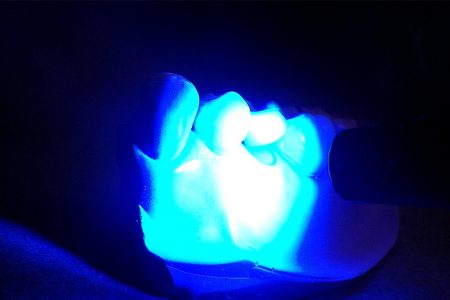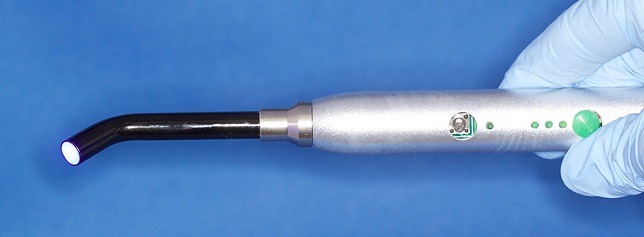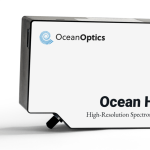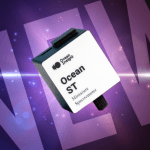Introduction
The next time you’re at the dentist getting a light-cured “filling”, more accurately known as a photocured resin-based composite (RBC), you might want to take a peek at the brand name on the “blue light wand” they’re about to use. You see, unlike sterilization or x-ray equipment, there is no mandatory testing of dental curing lights used in dental offices and not all LED-based dental light-curing units (LCUs) are created equal.
Recent studies have shown the light output irradiance profiles from some LCUs to be highly inhomogeneous, with hot and cold spots of irradiance across their light tip. This has a direct impact on the polymerization process in the RBC, affecting how well the filling is cured at the surface and within the resin, with consequences to lifetime and safety. Dental radiometers, by their design, are unable to fully characterize the output of dental LCUs, and can provide misleading readings to dental professionals. This can be of particular concern for battery-powered LCUs that must maintain their performance as the battery discharges. Curious to see how budget LCUs that are widely available over the internet would stack up in a head-to-head comparison against the more established brands, an international team of dental scientists led by Dr. Richard Price at Dalhousie University in Halifax, Canada put an Ocean Optics USB4000 spectrometer to work.
“Dentists have a responsibility to inquire about the truth, accuracy and performance of products to help ensure they are providing safe and effective care for their patients.” – The American Dental Association
Dental Radiometers – An Imperfect “Cure”
More than 260 million RBC dental restorations are placed every year, and the dental industry in China has responded with the availability of largely untested “budget” LCUs that are available for sale online for as little as $9 compared to the ~$1,000 price tag for a good quality light from a major manufacturer. But are the cost savings worth it? These budget light appear to be as good as lights purchased from major dental manufacturers because the blue light is so bright you cannot tell the difference with the naked eye, the irradiance values are often the same, and the top surface of the filling is hard to touch. The dental radiometers typically used in-office to verify the output of an LCU day to day simply don’t provide enough information to properly characterize an LCU’s performance. Dental radiometers typically have a small input port, making them sensitive to the relative position of the curing tip to the radiometer opening. They also incorporate filters, measure different spectral ranges and sometimes even blocking relevant curing wavelengths used for some resins.
One study of four dental radiometers found that, as a group, their readings varied by more than ±20% from radiometric measurements of the same curing light taken using NIST-referenced laboratory-grade systems. Readings from dental radiometers often differ from those taken as per the ISO 10650:2015 standard for the requirements and test methods for LCUs, and are adequate only for monitoring the same LCU over time (provided the relative position of the LCU to radiometer can be kept consistent each time).
Experimental Method4
Three models of low-cost LCUs were purchased from the internet (3 units each) for comparison against three LCU models from major dental manufacturers (2-3 units each). Absolute irradiance spectra for each unit were measured using an Ocean Optics USB-series spectrometer, configured and calibrated with a 6” (~15 cm) integrating sphere and NIST-traceable lamp from our sister company, Labsphere. The spectral radiant power (in mW/cm2/nm) and the integrated radiant power (in mW/cm2) from 350-550 nm was recorded.
In addition to the spectral measurements, the total radiant power in mW for each model was measured using a thermopile, and the radiant power from across the light tip was measured using a laser beam profiler. A micrometer was used to measure the outer diameter of the LCU tip, as well as its active optical diameter.
Spectral & Irradiance Results
Figure 1: Spectral radiance power curves for three brand-name dental curing lights (A, B, C, in red) and three unregulated budget curing lights (D, E, F, in blue). (Image from Journal of Operative Dentistry)
The spectral emission from most of the tested LCUs were similar, with a primary peak centered at 449-455 nm. One budget LCU was noticeably lower in power, while one brand-name LCU had a second emission peak at 411 nm.
The average irradiance measured for each LCU model was within 100 mW/cm2 of the manufacturer’s specified value (which ranged from 1000-2100 mW/cm2). The spatial distribution of this irradiance, however, varied across the LCU tip in each case, sometimes dramatically. The brand-name LCUs had hot spots that were up to 900 mW/cm2 above the average irradiance, while, in some locations, the budget LCUs rocketed as much as 12,000 mW/cm2above the average irradiance. The budget LCUs also showed nonuniform and incomplete coverage when only the regions of their beam profiles that delivered more than the minimum 400 mW/cm2 required output were superimposed over a typical molar tooth as if for curing. All budget LCUs were found to have smaller optical tip areas (0.31-0.39 cm2 vs. 0.59-0.61 cm2 for the brand-name LCUs). Such small light tips can deliver the same irradiance while delivering much lower radiant power compared to a light with a larger tip. Since most dental radiometers only report the irradiance, the dentist will not realize that the budget light may only deliver a fraction of the power (Figure 2F) compared to a quality light from a major manufacturer (Figure 2A). In addition, using small tips can result in insufficient coverage of the outer regions of the typical molar tooth, risking incomplete curing of the filling.
Irradiance with Battery Drain
While battery-powered LCUs are convenient, they must be designed to maintain the same output power as the battery drains, with safeguards to notify the dentist when irradiance levels begin to fall below the minimum of 400 mW/cm2. To assess performance over time for each model, the Ocean Optics spectrometer was configured to measure the last 10 seconds of each exposure for at least 100 exposures while the battery drained (indicative of a typical day’s use).
The brand-name LCU models (Figure 2: A, B, C) were found to be much more stable, delivering consistent output power for at least 100 exposures each. Of the budget LCU models, two (Figure 2: D, E) began immediately to decrease in irradiance. Of concern is that the dentist has no way of knowing this is occurring. The third (Figure 2F) remained stable until 700 exposures, albeit at much lower power levels, before dropping off rapidly.
When battery levels started to drop, the brand-name models began to beep, and later turned off as a safeguard against incomplete curing. The budget models, however, gave insufficient to zero notification of battery drain, and continued operating when their output was well below the threshold to effectively cure the resin filling.
Figure 2: Output power vs number of exposures for three brand-name dental curing lights (A, B, C) and three unregulated dental curing lights (D, E, F). (Image from Journal of Operative Dentistry)
Conclusions
Budget LED curing units offer much less uniformity than tested and approved brand-name models, despite delivering their average and apparently acceptable irradiance specification. This can have undesirable effects in a clinical setting, including excessive local heating of tissues and incomplete curing leading eventually to bulk cracks, secondary caries, and breakdown of the restoration at the margins. Additionally, the budget LCUs tested do not offer sufficient overall irradiance, output stability, safeguards, and lifetime needed to deliver effective and consistent curing of resin fillings. When it comes to dental health, the risk of using an untested device is simply not worth the savings. Ocean Optics is leading the way in providing equipment that can accurately measure the radiant power and emission spectrum from dental curing lights.
See how the dental industry is responding to the hazards of the “gray market”.
References
- Price, R.B., et al. “Irradiance uniformity and distribution from dental light curing units.” Journal of Esthetic and Restorative Dentistry 22.2 (2010): 86-101.
-
Price, Richard BT, et al. “Correlation between the beam profile from a curing light and the microhardness of four resins.” Dental Materials 30.12 (2014): 1345-1357.
-
Magalhaes Filho T,R,, et al. ‘Effect of LED-LCU light irradiance distribution on mechanical properties of resin based materials’. Materials Science & Engineering. C: Materials for Biological Applications 63 (2016):301-307.
-
Al Shaafi, M. M., et al. “Emission Characteristics and Effect of Battery Drain in “Budget” Curing Lights.” Operative Dentistry (2015). [Epub ahead of print]
-
Price, R.B., et al. “Intra-and inter-brand accuracy of four dental radiometers.” Clinical Oral Investigations 16.3 (2012): 707-717.
-
ISO 10650:2015 (2015) Dentistry—“Dentistry — Powered polymerization activators” Geneve: International Organization for Standardization.






